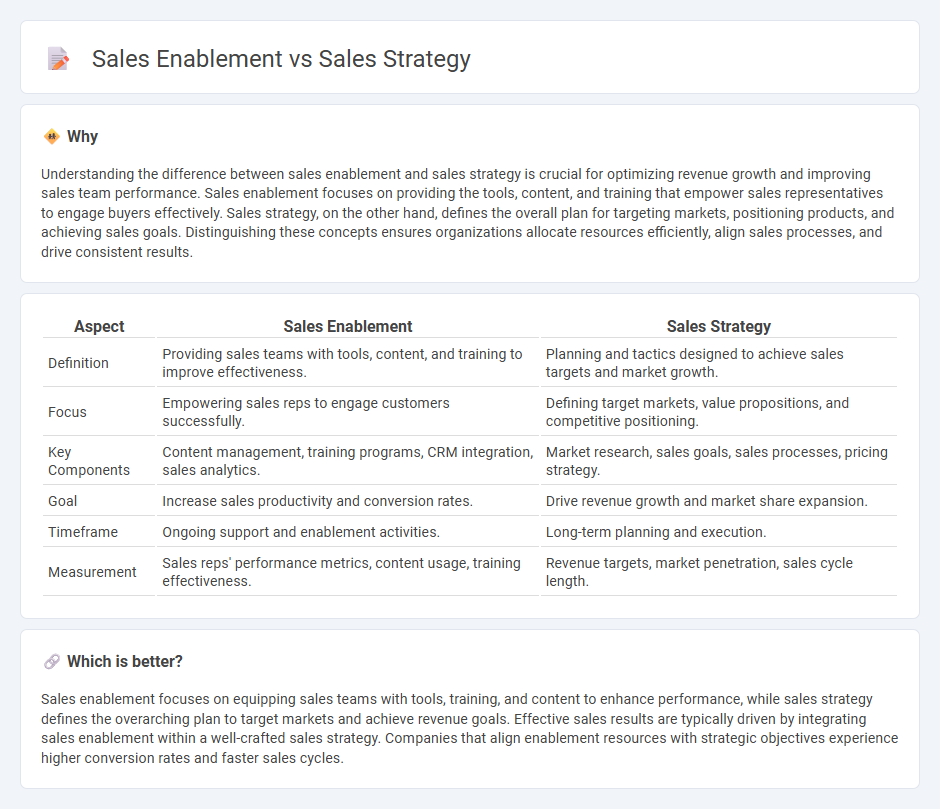
Sales enablement equips sales teams with the tools, content, and training necessary to engage buyers effectively and close deals faster. In contrast, sales strategy focuses on planning and executing long-term goals, identifying target markets, and defining competitive positioning to drive revenue growth. Explore the distinct roles of sales enablement and sales strategy to optimize your sales performance.
Why it is important
Understanding the difference between sales enablement and sales strategy is crucial for optimizing revenue growth and improving sales team performance. Sales enablement focuses on providing the tools, content, and training that empower sales representatives to engage buyers effectively. Sales strategy, on the other hand, defines the overall plan for targeting markets, positioning products, and achieving sales goals. Distinguishing these concepts ensures organizations allocate resources efficiently, align sales processes, and drive consistent results.
Comparison Table
| Aspect | Sales Enablement | Sales Strategy |
|---|---|---|
| Definition | Providing sales teams with tools, content, and training to improve effectiveness. | Planning and tactics designed to achieve sales targets and market growth. |
| Focus | Empowering sales reps to engage customers successfully. | Defining target markets, value propositions, and competitive positioning. |
| Key Components | Content management, training programs, CRM integration, sales analytics. | Market research, sales goals, sales processes, pricing strategy. |
| Goal | Increase sales productivity and conversion rates. | Drive revenue growth and market share expansion. |
| Timeframe | Ongoing support and enablement activities. | Long-term planning and execution. |
| Measurement | Sales reps' performance metrics, content usage, training effectiveness. | Revenue targets, market penetration, sales cycle length. |
Which is better?
Sales enablement focuses on equipping sales teams with tools, training, and content to enhance performance, while sales strategy defines the overarching plan to target markets and achieve revenue goals. Effective sales results are typically driven by integrating sales enablement within a well-crafted sales strategy. Companies that align enablement resources with strategic objectives experience higher conversion rates and faster sales cycles.
Connection
Sales enablement provides sales teams with the tools, content, and training necessary to execute a well-defined sales strategy effectively. A strong sales strategy outlines target markets, buyer personas, and value propositions, which sales enablement tailors into actionable resources for front-line sellers. Aligning enablement initiatives with strategic goals boosts sales productivity, shortens sales cycles, and improves win rates.
Key Terms
**Sales Strategy:**
Sales strategy involves planning and executing targeted approaches to reach sales goals by identifying market segments, defining value propositions, and allocating resources effectively. This strategic blueprint drives revenue growth through competitive analysis, customer insights, and optimized sales processes. Explore deeper insights on how a robust sales strategy can transform business outcomes.
Target Market
Sales strategy centers on defining and targeting the ideal customer segments to maximize revenue and growth opportunities. Sales enablement equips sales teams with tools, content, and training tailored to engage those specific market segments effectively. Explore how aligning sales enablement with your target market can drive exceptional sales performance.
Value Proposition
Sales strategy centers on defining the value proposition to target specific market segments and drive revenue growth through tailored messaging and positioning. Sales enablement equips sales teams with tools, content, and training that reinforce the value proposition, ensuring consistent communication and increased buyer engagement. Discover how aligning sales strategy with sales enablement maximizes your value proposition impact.
Source and External Links
8 Effective Sales Strategies, Examples, and Best Practices for ... - Clari - A comprehensive guide on creating a sales strategy including setting goals, understanding your audience, analyzing competition, choosing sales channels, pricing, sales messaging, tools, training, methodology, and budgeting.
How to Develop a Winning Sales Strategy for 2025 - Atlassian - Outlines 5 key steps to building a sales strategy: formulating clear goals with the SMART framework, developing ideal customer profiles (ICPs), and training sales teams.
22 Best Sales Strategies, Plans, & Initiatives for Success [Templates] - Presents practical effective sales strategies like increasing online sales via social media, prioritizing inbound leads, demonstrations, personalized messaging, confidence in closing deals, and nurturing accounts.
 dowidth.com
dowidth.com